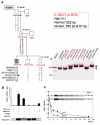Evidence that SIZN1 is a candidate X-linked mental retardation gene
- PMID: 18798319
- PMCID: PMC2575800
- DOI: 10.1002/ajmg.a.32472
Evidence that SIZN1 is a candidate X-linked mental retardation gene
Abstract
An estimated 1-3% of individuals within the United States are diagnosed with mental retardation (MR), yet the cause is unknown in nearly 50% of the patients. While several environmental, genetic and combined teratogenetic etiologies have been identified, many causative genes remain to be identified. Furthermore, the pathogenetic mechanisms underlying MR are known for very few of these genes. Males have a much higher incidence of MR implicating genes on the X-chromosome. We have recently identified a novel gene, SIZN1, on the X-chromosome and showed that it functions in modulating the BMP signaling pathway. Furthermore, we have shown this gene is necessary for basal forebrain cholinergic neuron (BFCN) specific gene expression. Given that cognitive function is impaired when BFCNs are lost or functionally disrupted, we undertook a screen of cognitively impaired males for SIZN1 mutations. We report on four different sequence variants in SIZN1 in 11 individuals with nonsyndromic X-linked mental retardation (XLMR). Our data implicate SIZN1 as a candidate gene for XLMR and/or as a neurocognitive functional modifier.
2008 Wiley-Liss, Inc.
Figures



References
-
- Aicardi J. The etiology of developmental delay. Semin Pediatr Neurol. 1998;5:15–20. - PubMed
-
- Baxter MG, Chiba AA. Cognitive functions of the basal forebrain. Curr Opin Neurobiol. 1999;9:178–183. - PubMed
-
- Counts SE, Nadeem M, Wuu J, Ginsberg SD, Saragovi HU, Mufson EJ. Reduction of cortical TrkA but not p75(NTR) protein in early-stage Alzheimer’s disease. Ann Neurol. 2004;56:520–531. - PubMed
-
- Gallagher M, Colombo PJ. Ageing: the cholinergic hypothesis of cognitive decline. Curr Opin Neurobiol. 1995;5:161–168. - PubMed
Publication types
MeSH terms
Substances
Grants and funding
LinkOut - more resources
Full Text Sources
Molecular Biology Databases

